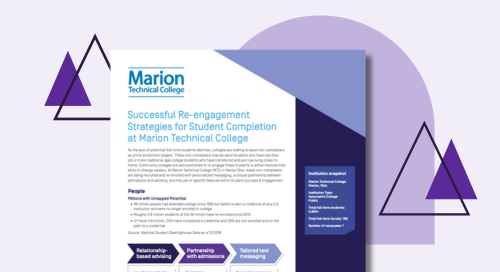As the pool of potential first-time students declines, colleges are looking to adult non-completers as prime enrollment targets. These non-completers may be adult students who have lost their job or more traditional-age college students who have transferred and are now living closer to home. Community colleges are well positioned to re-engage these students to either improve their skills or change careers. At Marion Technical College (MTC) in Marion Ohio, these non-completers are being recruited and re-enrolled with personalized messaging, a unique partnership between admissions and advising, and the use of specific features within Student Success & Engagement.


Source: National Student Clearinghouse Data as of 12/2018
Notes should include registration information and other items of discussion such as outside responsibilities and barriers they are facing both in the classroom and in life. Personal notes not only help build relationships; they allow the institution to address specific barriers (financial aid, child care, conflicting work schedules) keeping students out of the classroom.
When recruiting students to re-enroll, academic plans can help the institution see how close they are to completing a credential, and use this information to tailor its messaging. The institution can also run what-if analyses for students to see if they might be closer to a degree in different areas or no longer want to continue on the path they were on.
Advisors can run and manage their own lists, which are constantly updated in real time. Using filters, they are able to create different searches based on their needs, such as students who were last enrolled in specific terms. Institutions can also create tags in Student Success & Engagement for certain groups they want to target, such as students who stopped out.
With Student Success & Engagement, institutions can easily send mass emails or individual messages to a secondary email account on file. Since email addresses change less often, a personal email address is a good way to reach students if they have moved or changed phone numbers since they last attended.
| 31% of adult ‘stop-outs’ at MTC complete their degrees. They average 33 earned credits before re-enrolling. | ||
| MTC adult ‘stop-outs’ in Spring 2020 account for approximately $170,000 in revenue. | ||
| Students interacting with their support team demonstrate a 6% increase in their rate of persistence. |
“Regardless, the end goal is to help as many students as possible complete their degrees. Currently in the United States, there are 36 million students with some credit and no degree. That is untapped talent and economic potential for both individuals and communities. We know that degree completion not only boosts individual earnings by giving students pathways to wage sustaining, high demand jobs, but it also meets the employment needs of local employers and increases the economic vitality of the community and region.”
Laura Emerick, Executive Director of Advising and Student Engagement, Marion Technical College

See how our tools are helping clients right now, get in-depth information on topics that matter, and stay up-to-date on trends in higher ed.